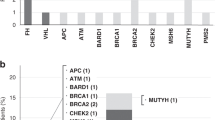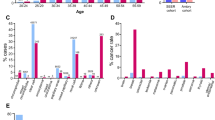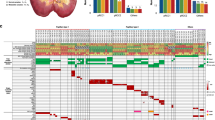Abstract
Mutations in the von Hippel-Lindau (VHL) gene are frequently detected in human sporadic renal cell carcinoma (RCC). We analysed 102 Swedish RCCs for VHL mutations by PCR–SSCP and sequencing. In 47 patients (46.1%), 70 different mutations were found, and most of them represented novel variations of the VHL gene. Mutations in the VHL gene were found in 54% of clear cell renal cell carcinomas (CCRCC) and in 18% of chromophilic cancers but in no chromophobe cancers or oncocytomas (P=0.016). Three novel hotspot or founder mutations were detected in our study: four CCRCCs carried a missense mutation (glutamic acid to lysine) at codon 160 which is critical in the stabilization of the H1 helix of the α domain and the α-β domain interface in the VHL protein. Five CCRCCs and one chromophilic RCC harbored a 15-nucleotide in-frame deletion (codons 41–45) at a duplex tandem repeat sequence site. Moreover, this deletion was in linkage disequilibrium with a C→T transition in the promoter region. The frequency of linkage was 17 times more common than chance. Five patients with this linked mutation resided in the same hospital district and at least three of them showed the two sequence variants in the tumor-adjacent tissue. In 5/6 patients the wild-type allele was lost in the tumor samples, suggesting a causal role for the mutations in RCC. These linked mutations might be novel polymorphisms maintained in a relative isolated population. Multiple mutations in VHL were found in 17 tumors out of 47 tumors with the VHL mutation. A higher multiple mutation detected rate (33%) was observed in grade 3 CCRCCs than those in grade 1 (22%) and grade 2 (9%) (P=0.04). This is evidence on the association between VHL mutation and extent of nuclear atypia.
This is a preview of subscription content, access via your institution
Access options
Subscribe to this journal
Receive 50 print issues and online access
$259.00 per year
only $5.18 per issue
Buy this article
- Purchase on Springer Link
- Instant access to full article PDF
Prices may be subject to local taxes which are calculated during checkout


Similar content being viewed by others
References
Beroud C, Joly D, Gallou C, Staroz F, Orfanelli MT, Junien C . 1998 Nucleic Acids Res. 26: 256–258
Brauch H, Weirich G, Brieger J, Glavac D, Rodl H, Eichinger M, Feurer M, Weidt E, Puranakanitstha C, Neuhaus C, Pomer S, Brenner W, Schirmacher P, Storkel S, Rotter M, Masera A, Gugeler N, Decker HJ . 2000 Cancer Res. 60: 1942–1948
Brauch H, Weirich G, Hornauer MA, Storkel S, Wohl T, Bruning T . 1999 J. Natl. Cancer Inst. 91: 854–861
Bruning T, Weirich G, Hornauer MA, Hofler H, Brauch H . 1997 Arch. Toxicol. 71: 332–335
Crossey PA, Richards FM, Foster K, Green JS, Prowse A, Latif F, Lerman MI, Zbar B, Affara NA, Ferguson-Smith MA . 1994 Hum. Mol. Genet 3: 1303–1308
Day RSD, Babich MA, Yarosh DB, Scudiero DA . 1987 J. Cell Sci. Suppl 6: 333–353
Denissenko MF, Chen JX, Tang MS, Pfeifer GP . 1997 Proc. Natl. Acad. Sci. USA 94: 3893–3898
Foster K, Prowse A, van den Berg A, Fleming S, Hulsbeek MM, Crossey PA, Richards FM, Cairns P, Affara NA, Ferguson-Smith MA, Buys CHCM, Maher ER . 1994 Hum. Mol. Genet. 3: 2169–2173
Gnarra JR, Tory K, Weng Y, Schmidt L, Wei MH, Li H, Latif F, Liu S, Chen F, Duh FM, Lubensky I, Duan DR, Florence C, Pozzatti R, Walther MM, Bander NH, Grossman HB, Brauch H, Pomer S, Brooks WB, Isaacs WB, Lehman MI, Zbar B, Linehan WM . 1994 Nat. Genet. 7: 85–90
Gorospe M, Egan JM, Zbar B, Lerman M, Geil L, Kuzmin I, Holbrook NJ . 1999 Mol. Cell Biol. 19: 1289–1300
Greenblatt MS, Bennett WP, Hollstein M, Harris CC . 1994 Cancer Res. 54: 4855–4878
Latif F, Tory K, Gnarra J, Yao M, Duh FM, Orcutt ML, Stackhouse T, Kuzmin I, Modi W, Geil L, Schmidt L, Zhou F, Li H, Wei MH, Chen F, Glenn G, Choyke P, McClellan MW, Weng Y, Duan D-SR, Dean M, Glavac D, Richards FM, Crossey PA, Ferguson-Smith MA, Le Paslier D, Chumakov I, Cohen D, Chinault AG, Maher ER, Linehan WM, Zbar B, Lerman MI . 1993 Science 260: 1317–1320
Lindahl T . 1993 Nature 362: 709–715
Mandel JS, McLaughlin JK, Schlehofer B, Mellemgaard A, Helmert U, Lindblad P, McCredie M, Adami HO . 1995 Int. J. Cancer 61: 601–605
McCredie M, Pommer W, McLaughlin JK, Stewart JH, Lindblad P, Mandel JS, Mellemgaard A, Schlehofer B, Niwa S . 1995 Int. J. Cancer 60: 345–349
McLaughlin JK, Lindblad P, Mellemgaard A, McCredie M, Mandel JS, Schlehofer B, Pommer W, Adami HO . 1995 Int. J. Cancer 60: 194–198
McLaughlin JK, Lipworth L . 2000 Semin. Oncol 27: 115–123
Meyer AJ, Hernandez A, Florl AR, Enczmann J, Gerharz CD, Schulz WA, Wernet P, Ackermann R . 2000 Int. J. Cancer 87: 650–653
Pause A, Lee S, Worrell RA, Chen DY, Burgess WH, Linehan WM, Klausner RD . 1997 Proc. Natl. Acad. Sci. USA 94: 2156–2161
Prowse AH, Webster AR, Richards FM, Richard S, Olschwang S, Resche F, Affara NA, Maher ER . 1997 Am. J. Hum. Genet. 60: 765–771
Schoenfeld AR, Davidowitz EJ, Burk RD . 2000a Proc. Natl. Acad. Sci. USA 97: 8507–8512
Schoenfeld AR, Parris T, Eisenberger A, Davidowitz EJ, De Leon M, Talasazan F, Devarajan P, Burk RD . 2000b Oncogene 19: 5851–5857
Schraml P, Zhaou M, Richter J, Bruning T, Pommer M, Sauter G, Mihatsch MJ, Moch H . 1999 Verh. Dtsch. Ges. Pathol. 83: 218–224
Sekido Y, Bader SA, Latif JR, Gnarra AF, Gazdar WM, Linehan B, Zbar MI, Lerman JD, Minna JD . 1994 Oncogene 9: 1599–1604
Shiao YH, Rice JM, Anderson LM, Diwan BA, Hard GC . 1998 J. Natl. Cancer Inst. 90: 1720–1723
Siemeister G, Weindel K, Mohrs K, Barleon B, Martiny-Baron G, Marme D . 1996 Cancer Res. 56: 2299–2301
Stebbins CE, Kaelin Jr WG, Pavletich NP . 1999 Science 284: 455–461
Thoenes W, Rumpelt HJ, Storkel S . 1990a Klin. Wochenschr. 68: 1102–1111
Thoenes W, Storkel S, Rumpelt HJ, Moll R . 1990b Eur. Urol. 18: 6–9
Yang K, Lindblad P, Egevad L, Hemminki K . 1999 Cancer Lett. 141: 1–8
Yoshida M, Ashida S, Kondo K, Kobayashi K, Kanno H, Shinohara N, Shitara N, Kishida T, Kawakami S, Baba M, Yamamoto I, Hosaka M, Shuin T, Yao M . 2000 Jpn. J. Cancer Res. 91: 204–212
Zhuang Z, Gnarra JR, Dudley CF, Zbar B, Linehan WM, Lubensky IA . 1996 Mod. Pathol. 9: 838–842
Acknowledgements
The study was supported by the Swedish Cancer Society.
Author information
Authors and Affiliations
Corresponding author
Rights and permissions
About this article
Cite this article
Ma, X., Yang, K., Lindblad, P. et al. VHL gene alterations in renal cell carcinoma patients: novel hotspot or founder mutations and linkage disequilibrium. Oncogene 20, 5393–5400 (2001). https://doi.org/10.1038/sj.onc.1204692
Received:
Revised:
Accepted:
Published:
Issue Date:
DOI: https://doi.org/10.1038/sj.onc.1204692
Keywords
This article is cited by
-
MCPIP1 contributes to clear cell renal cell carcinomas development
Angiogenesis (2017)
-
Novel tumor suppressive function of Smad4 in serum starvation-induced cell death through PAK1–PUMA pathway
Cell Death & Disease (2011)
-
Alterations in VHL as potential biomarkers in renal-cell carcinoma
Nature Reviews Clinical Oncology (2010)
-
Targeting vascular endothelial growth factor (VEGF)-receptor-signaling in renal cell carcinoma
World Journal of Urology (2007)
-
Prevalence of von Hippel-Lindau gene mutations in sporadic renal cell carcinoma: results from the Netherlands cohort study
BMC Cancer (2005)



